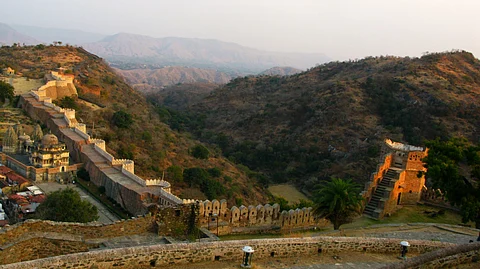
- Destinations
- Experiences
- Stay
- What's new
- Celebrating People
- Responsible Tourism
- CampaignsCampaigns
- Subscribe
- Buy Now

An architectural wonder that perfectly captures the genius of ancient Indian engineering is the Great Wall of India, which is situated in Kumbhalgarh, Rajsamand, Rajasthan. This striking UNESCO World Heritage Site building, which encircles Kumbhalgarh Fort, is frequently referred to as India’s version of the Great Wall of China. It is the second-longest continuous wall in the world, spanning more than 36 kilometres, and has long protected the area’s architectural, cultural, and historical legacy. It is an essential destination for history buffs, architecture lovers, and tourists looking for unusual experiences because of its undulating structure, dramatic landscapes, and historical significance. Let us delve into all the details about the great wall that a traveller needs to know before embarking on a journey.
In the fifteenth century, under the rule of Rana Kumbha, a strong Rajput monarch of the Mewar dynasty, the Great Wall of India was built. It was constructed mainly as a strategic defence mechanism against invasions to safeguard the Kumbhalgarh Fort. Often referred to as the "Kumbhalgarh Wall," the wall was constructed over several decades with the help of skilled craftspeople and labourers, as well as local resources.
Built in the fifteenth century under the rule of Rana Kumbha, a strong Rajput monarch of the Mewar dynasty, the Great Wall of India was constructed mainly as a strategic defence mechanism against invasions to safeguard the Kumbhalgarh Fort. Often referred to as the "Kumbhalgarh Wall," the wall was built over several decades with the help of skilled craftspeople and labourers, as well as local resources. The wall's construction served as both a military tactic and a testament to Mewar's tenacity and inventiveness as an architect.
According to legend, the building of the wall encountered many difficulties until a local sage suggested that a human sacrifice was required to please the gods. The story goes that a volunteer came forward, and a shrine at the location honours his sacrifice.
The Great Wall of India stands as a masterful example of medieval architecture, seamlessly blending practicality with beauty. Averaging 15 feet in width, the wall is robust enough to support both horses and soldiers as they patrol its length. Constructed from large stone blocks and lime mortar, the wall features watchtowers and bastions that offer sweeping views of the Aravalli Hills and the surrounding forests, which once served as a natural defense against intruders.
Seven fortified gateways, or pols, that served as entry points to the fort are also located within the wall. The intricate stonework and carvings on these gates bear witness to the period's artistic prowess. Small temples, water tanks, and stepwells lining the wall demonstrate its multipurpose use, meeting the needs of both soldiers and civilians during protracted sieges.
The wall seamlessly blends with the rocky terrain, which is its most remarkable feature. Its curved shape, following the natural contours of the hills, enhances both aesthetic appeal and practicality.
The primary attraction near the Great Wall of India is Kumbhalgarh Fort, which is situated at an elevation of 1,100 meters. The fort is famous for its massive gates, luxurious palaces, and over 360 temples. Among these, the Badal Mahal, also known as the Palace of Clouds, stands out for its stunning architecture and spectacular views of the Aravalli Hills.
Next to the wall is the Kumbhalgarh Wildlife Sanctuary, a paradise for nature enthusiasts. The sanctuary offers a refuge for wildlife lovers and photographers alike, as it is home to a diverse range of flora and fauna, including sloth bears, wolves, leopards, and various species of birds.
The nearby village of Rajsamand is famous for Rajsamand Lake, an artificial waterbody created during the reign of Maharana Raj Singh. The lake's beautiful surroundings and marble embankments make it an ideal spot for a peaceful outing. Just a short drive away are the Jain temples at Ranakpur, which offer a serene atmosphere amidst stunning marble architecture.
Walking along the Great Wall of India is a surreal experience. While the entire stretch may be daunting, even a short hike offers unparalleled views of the fort, hills, and forests. Many visitors enjoy guided tours that delve into the history, architecture, and anecdotes associated with the wall and the fort.
Adventure enthusiasts can participate in trekking expeditions through the Kumbhalgarh Wildlife Sanctuary, which offers trails that pass through dense forests and open meadows. Camping under the starry skies near the wall is another popular activity, providing an immersive experience of the region’s natural beauty.
Photography opportunities abound, from capturing the grandeur of the wall and fort to documenting the vibrant flora and fauna of the sanctuary. The region is also a hub for cultural experiences, with traditional Rajasthani music and dance performances often organised in and around Kumbhalgarh.
Kumbhalgarh is well-connected to major cities in Rajasthan. The nearest airport is Udaipur’s Maharana Pratap Airport, approximately 85 kilometres away, while Falna is the nearest railway station, 49 kilometres from the site. Regular buses and taxis operate from Udaipur, Rajsamand, and other nearby towns.
Visitors are advised to wear comfortable walking shoes and carry sufficient water, especially if they plan to hike along the wall or explore the sanctuary. The best time to visit is between October and March, when the weather is pleasant, and the region’s natural beauty is at its peak.
Address: Kumbhalgarh, Rajasthan 313325
Timings: 9 am to 6 pm
Entry Fees: INR 10 for Indian nationals and INR 100 for foreigners
Air: The nearest airport to Kumbhalgarh is the Maharana Pratap Airport in Udaipur, which is about 85 kilometers away.
Rail: Take the train to Falna Railway Station, which is about 50 kilometers away. Falna is a junction railway station that's well-connected to major cities like Delhi, Jaipur, and Ahmedabad.
Road: Kumbhalgarh is well-connected by roads and you can hire a cab or car service.
